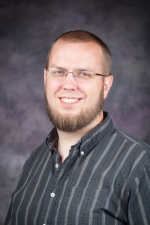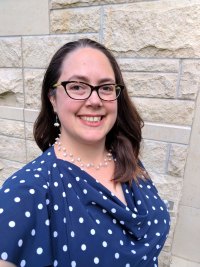NSF REU at K-State: Interactions of Matter, Light and Learning
The K-State REU program offers summer fellowships to do world-class research in our friendly physics department in the scenic Flinthills. We are funded by the National Science Foundation.
Physics Education Research (PER)
Dr. J.T. Laverty
Email: laverty@phys.ksu.edu

|
| J.T. Laverty |
When and where do students learn to construct explanations of force and motion? How often do students get to plan and carry out investigations of energy in class? National reports are calling for the inclusion of the process of science in our classrooms at the same level of emphasis as the content of science; In essence, refocusing our educational environments on learning to do science, not just know science. Accomplishing this task requires a critical look at curriculum, instruction, and assessment in our courses. The research community is still in the early stages of this transformation, which means much of the work is focused on reliably identifying when students are engaging in both the process and concepts of science. The following projects focus on these research questions:
Project 1: Do curricular materials provide opportunities for students to engage in Scientific Practices?
In this project, you will be looking at problem sets from introductory physics textbooks and/or classrooms and searching for scientific practices. A protocol has already been developed to identify homework and exam problems that align with scientific practices. In this project, you will learn to apply this protocol to existing questions and analyze existing curricular materials with it. No special training or preparation is needed to be a part of this project.
Project 2: How do know if we are teaching Scientific Practices?
This project is focused on reliably identifying when scientific practices are being included in classroom instruction. You will analyze recordings of introductory physics classes (lecture hall or studio), trying to identify when and where scientific practices are being presented to students. There are no special requirements for this project.
Project 3: How can we tell if students are engaging in Scientific Practices?
In this project, you will analyze recordings of students working in groups on projects specifically designed to engage students in scientific practices. This project will involve watching these recordings to find exemplar segments of students engaging in one or more scientific practices. Once several exemplars have been found, the goal will be to abstract common features of those exemplars that future researchers can use to reliably determine when students are engaging in those scientific practices (such as Engaging in Argument from Evidence or Developing and Using Models). No special training is needed to be involved in this project.
Dr. Eleanor Sayre
Email: esayre@phys.ksu.edu

|
| Eleanor Sayre |
This study investigates how upper-division electromagnetic fields (EM) students think about solving problems. We collected videos of students solving homework problems in an upper-division EM course. We have already investigated whether the problem solving videos helped students learn (they do!), but we don't know what about making the videos was most helpful. In this project, you will delve into the videos looking for how students build arguments and use mathematics to reason about physics. This is a great project to join if you want to learn how to do qualitative, video-based research. You must have taken EM to join this project.
Project 1: Central ideas in physics education research
What does physics education research (PER) do? How has the field changed over time? This project analyzes the abstracts from our biggest conferences to detect sub-communities, research topics, and changes over time. We use methods from computational linguistics and social network analysis to cluster abstracts, and merge those clusters with enriched co-authorship networks to figure out how ideas spread through PER, looking at both how ideas flow between research groups and how ideas change with time. This is a great project to join if you're interested in quantitative research, particularly natural language processing or social network analysis, or if you want to learn a broad overview of what research topics PER cares about. You don't need to know any of these methods ahead of time, but it would be helpful if you knew a little bit about programming (any language is ok).
Project 2: Social network analysis of co-authorship in PER
Social network analysis discovers how people or ideas are connected, how their connections change over time, and how their connections are affected by geographic location, gender, age, or other factors. In this project, we study the inception and growth of the research field by looking at how people within the field collaborate. We collected co-authorship data from the top three journals in PER. Initial results suggest that the PER community started coming together in 2006 and has been growing more intertwined ever since. You will augment our existing data with PER genealogy and info from other journals so that we can look for causal factors. Together with our collaborators at Carnegie Mellon, we will calculate network statistics to determine how the "shape" of the field has changed over time, and how people's connections depend on who they are and what they do. Your work will earn authorship in a paper (journal depends on your results). This is a great project if you're curious about computational models or network analysis. You should have some programming background (doesn't matter what language) to do well in this project.
Project 3: Sexism in physics
Physics, as a field, has underrepresentation from women and minorities It's getting better, but women are still only about 10-20% of physics and people of color are substantially underrepresented as well. Using data from the American Physical Society (APS) and the American Institute of Physics (AIP), we want to track just how much women and people of color are underrepresented in physics, how that has changed over time, and what possible causal stories can explain the data. If you choose this project, you'll spend the early parts of the summer analyzing data and the later parts of the summer writing a paper to submit to a research journal. This is a great project to join if you are interested in equity/fairness issues and like to write. You don't need any special skills to join this project.
Project 4: IMPRESS lab experiences
The IMPRESS project is an intensive two-week summer experience for incoming first-year university students who are Deaf/Hard-of-Hearing or the first generation in their families to go to college. IMPRESS students spend 6-8 hours every day building models of climate change and learning metacognitive skills to improve their persistence in science and engineering. The IMPRESS Education Research Squad (IMPRESSERS) collects and analyzes video of IMPRESS students. If you join IMPRESSERS, you'll investigate how students' ideas about the nature of science change as they go through the IMPRESS summer experience, and how their ideas depend on their metacognitive skills and their interactions with their group mates. This is a great project to join if you're concerned about equity/fairness, social issues, or student identity. You don't need any special background to join this project.